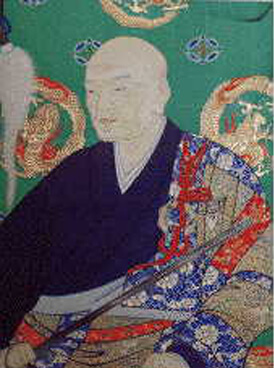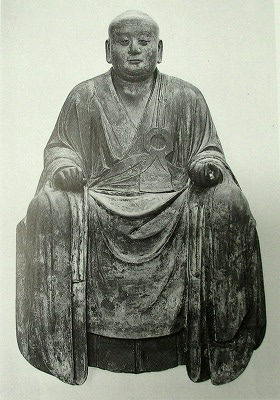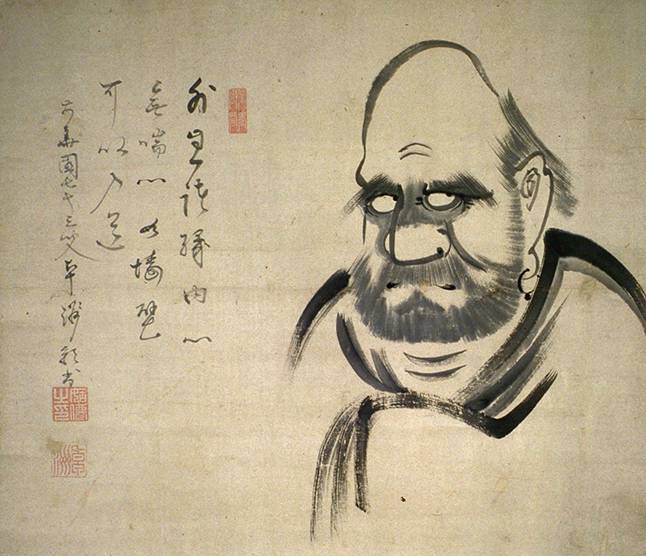ZEN MESTEREK ZEN MASTERS
« Zen főoldal
« vissza a Terebess Online nyitólapjára

卓洲胡僊 Takujū Kosen (1760–1833)
aka 大道円鑑禅師 Daidō Enkan zenji


Takujû Kosen (1760–1833)
Japanese Rinzai monk of the Tokugawa period (1600–1867) who is regarded as the founder of the Takujû school of Japanese Zen. Takujû was the Dharma heir of Gasan Jitô (1727–1348), a leading disciple of the reformer Hakuin Ekaku (1685–1768). He and his Dharma brother Inzan Ien (1751–1814) are credited with completing the process of systematizing kôan practice within the Rinzai sect. Takujû was born in Tsushima, near the city of Nagoya. He became a Buddhist monk at Sôken-ji in Nagoya at age fifteen and began a pilgrimage looking for a suitable master at age nineteen. He visited Gasan at Tôki-an and decided to join his assembly. Takujû requested permission to live separately and to be relieved of all of his monastic duties in order to concentrate exclusively on meditation. His request granted, he attained kenshô in a matter of ninety days. He then resumed his normal duties and practiced under Gasan for fourteen years. Gasan acknowledged him as a Dharma heir. Takujû then returned to his home temple Sôken-ji where he lived quietly for twenty years. He was appointed abbot at Myôshin-ji in 1813 and received a purple robe. This spread his reputation and he gathered a community of disciples at Sôken-ji. He also attracted many lay believers . He is especially known for the quality of his lectures on the Zen corpus. He received the posthumous name Daidô Enkan Zenji (Zen Master Round Mirror of the Great Way).
Takujû School
One of two major forms of Japanese Rinzai Zen founded by Takujû Kosen (1760–1833), a second generation descendent of Hakuin Ekaku (1685–1768). All active lineages of Rinzai Zen in Japan today descend from either the Takujû or the Inzan schools. The teaching methods and Zen style of the two schools are nearly identical. Together they encompass what is often known as “Hakuin Zen.”
Takujū's Dharma Lineage
[...]
白隱慧鶴 Hakuin Ekaku (1686-1769)
峨山慈棹 Gasan Jitō (1727-1797)
卓洲胡僊 Takujū Kosen (1760-1833) aka 大道円鑑禅師 Daidō Enkan zenji
蘇山玄喬 Sosan Genkyō (1798-1868) aka 神機妙用禅師 Jinki Myōyō zenji
TAKUJU KOSEN
Richard Bryan McDaniel: Zen Masters of Japan. The Second Step East. Rutland, Vermont: Tuttle Publishing, 2013.
Takuju Kosen was twenty years old when he came to study with Gasan. The master assigned him Joshu’s Mu!, and the young man threw himself into the practice. He requested permission to retire from the monastic community to a hermitage in order to dedicate all of his time to the koan. He practiced with such fervor that at one point he went for more than two weeks without either food or sleep. As a result of his efforts, he was able to attain kensho within ninety days.
After completing his training with Gasan, Takuju spent another twenty years in further solitude, deepening and integrating his understanding. Then he succeeded Inzan as abbot of Myoshinji.
Both Inzan and Takuju were effective teachers, but what commentators—such as the American Zen teacher Bernie Glassman—note was the difference in their personalities:
Inzan and Takuju had completely different personalities. Inzan was vigorous, very dynamic; Takuju was meticulous, very careful in his study. And thus two koan systems developed, having the characteristics of each teacher: one very dynamic, and one system requiring you to be very meticulous in examining all elements of each point of a koan.
The majority of Rinzai teachers today are direct Dharma descendants of one or the other of these two men, making use of the different approaches Inzan and Takuju took to koan study.
達磨図 Daruma by Takujū Kosen



Dharma Lineage
https://pl.wikipedia.org/wiki/Takuj%C5%AB_Kosen
-
-
-
-
-
-
-
-
-
-
-
-
-
-
-
-
-
-
-
-
-
-
-
-
-
- 71/44/17. Suigan Bunshu (1810-1874)
-
-
- 73/46/19. Yūzen Gentatsu (Sanshō-ken 'Three Lives Hut', 1842-1918)
-
-
Takuju Kosen, Daido Enkan (1760-1833)
http://www.ciolek.com/wwwvlpages/zenpages/hakuin.html
- Kaisan Sokaku, Bukoku Myogen (1768-1846) [2]
- Kyodo Etan (1808-1895) [2]
- Kyuho Ichisei (1833-1916) [2]
- Ten'o Erin (1859-1889) [2]
- Daishu Soju (1817-1889) [2]
- Kodo Genchu (1830-1890) [2]
- Yosan Soshiki (1779-1859) [2]
- Getsusan Kokyo, Daiki Myokan (1789-1855) [2]
- Seki'o Somin, Daitetsu Hogan (1794-1857) [2]
- Hoshu Zemmyo, Dai'ien Shokaku (1802-1872) [2]
- Shun'no Zenetsu, Reiki Jin'o, Toin-shitsu, Reikishn'u (1772-1844?) [2][24] [Acc. to [24] a disciple of Takujyu]
- some generations
- Mokurai Soen (1854-1930) [5]
- Myoki Soseki, Fu'o Myokaku (1774-1848) [2]
- - - - - - - - - - - - - - - - - - - - - - - - - - - - start of Myoki Soseki line - - - - - - - - - - - - - - - - - - - - - - - - - - - -
- Karyo Zuika (1790-1848) [2][Dates acc. to [5] are 1793-1859]
- Tankai Gensho (1811-1898) [2]
- Dokutan Sosan, Dokutan Toyota (1840-1917) [1]
- Kono Mukai, Mukai Koryo, Nanshinken (1864-1935) [1][24]
- Shibayama Zenkei (1894-1974) [31]
- Takayama Taigan (?-?) [source details to be provided]
[Head abbot of Toshun-ji in Yamaguchi] [51]
- Fukushima Keido (1932-1 March 2011) [51][xx]
[The Abbot of Tofuku-ji in Kyoto][20] Head abbot of Tofuku-ji form 1980- 2009 (he retired due to illness), and he was head of Tofuku-ji sect from 1991-2009. He was a long-time student, and dharma heir of Shibayama Zenkei and of Okada Kido. [51][52]]
- Nakamura Taiyu (1886-1954) [1]
- Miura Isshu (1903-12 Oct 1978 ) [1][43]
- Harada Daiun Sogaku (1871-1961) [6]
- - - - - - - - - - - - - - - - - - - - - - - - - - - - end of Myoki Soseki line - - - - - - - - - - - - - - - - - - - - - - - - - - - -
- Sozan Genkyo, Jinki Myoyo (1779-1868) [5][Dates acc. to [2], page 295 are 1798-1866. However, p. 201 lists the dates as 1798-1868]
- Kasan Zenryyo (1824-1893) [5][2]
- Sohan Genho (1848-1922) [2]
- Gempo Yamamoto, Genpo Yamamoto, Gempo Giyu (1865-1961) [2]
- - - - - - - - - - - - - - - - - - - - - - - - - - - - start of Gempo Yamamoto line - - - - - - - - - - - - - - - - - - - - - - - - - - - -
- Nakagawa Soen, Mitta Kutsu Soen (19 Mar 1907-11 Mar 1984) [6]
[Close friend and associate of Yasutani Hakuun. Taught Zen to Aitken Robert]
- Suzuki Sochu (1921-1 Jan 1990)
[Date of birth acc. to [3]. Date of death acc. to [12]
- Stuart Maurine (3 Mar 1922-26 Feb 1990)
[Date of birth acc. to [18]
- Eido Shimano (1932- ) [6]
[Teacher of The Zen Studies Society]
- - - - - - - - - - - - - - - - - - - - - - - - - - - - start of Eido Shimano line - - - - - - - - - - - - - - - - - - - - - - - - - - - -
- Afable, Jiro Andy (1943-) [27][36][54]
[A former member of Dai Bosatsu Zendo. A founder of Early Light Zendo located in Sturbridge, MA][54]
- Chayat, Sherry Roko (1943-) [27][40]
[Abbess of Zen Center of Syracuse Hoen-ji]
- Jaeckel, Roland Kyo-on Dokuro Chigan (?-) [56]
[Abbot of the former (fl. 2004-2011) Cambridge Buddhist Association, MA, US. Teacher at the Charles River Zen Community [57]].
- Kelly, Junpo Denis (?-) [28]
[Vice Abbott and Head Monk and Yoga Instructor at Dai-Bosatsu Zendo, Livingston Manor, New York, 1987 - 1993; Founder of the Hollow Bones Lay Order in 1999] [55]
- Marinello, Genjo Kokan (5 Nov 1954-) [44][45]
[Abbot of Dai Bai Zan Cho Bo Zen Ji temple in Seattle, WA.]
- Mortensen, John Denko Mokudo (1947-) [34]
[Abbot of Pine Hill Zendo, spiritual leader of Skandinavisk Zen Center in Denmark and also vice president of Zen Studies society in New York.]
- - - - - - - - - - - - - - - - - - - - - - - - - - - - end of Eido Shimano line - - - - - - - - - - - - - - - - - - - - - - - - - - - -
- Fujimori Kozen (?- )
- Immari Beijo (?- )
- Nakagawa Dokyu Kyudo (?- 29 Dec 2007)[42]
[Abbot of Ryutaku-ji, Mishima, Japan][29]
- - - - - - - - - - - - - - - - - - - - - - - - - - - - end of Gempo Yamamoto line - - - - - - - - - - - - - - - - - - - - - - - - - - - -
- Tsuzan Soen (?- )
- Tetsuo Chisei (1879-1837) [2]
- Horin Ginan (1847-1898) [2]
- Tsu'o Sotetsu (1868-1933) [2]
- Choshu Genkai (1830-1903) [2]
- Tankai Genju (1832-1903) [2]
- Gisen Monetsu (1845-1915) [2]
- Rasan Gemma, Razan Genma (1815-1867) [5][2]
- Mugaku Bun'eki (1818-1887) [2]
- Daiko Sojun (1841-1911) [2]
- Nan'in Zengu (1834-1904) [5][2]
- Toshu Zenchu, Nantembo, Byakugai-kutsu (1839-1925) [2]
- Ko'in Jiteki (1866-1909) [2]
- Goten Dokei (1814-1891) [2]
- Jitsuso Teijin (1851-1909) [2]
- Hogaku Soju (1825-1901) [2]




